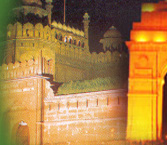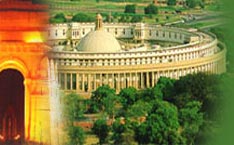Safdarjung�s tomb in New Delhi is a beautiful tomb built in the 18th century. It is one of the most famous tombs in New Delhi, and is visited by many tourists on their visit to New Delhi. Unlike the better known Mughul mausoleums like the Humayun�s tomb, and of course, the Taj Mahal in Agra, Safdarjung�s tomb is a much simpler structure, reflecting the decline in the scale of building during the rule of the last few Mughul rulers. Nevertheless, this tomb is considered to be among the tourist attractions of New Delhi.
Safdarjung was the title given to the wazir (prime minister) of the Mughul Emperor Mohammad Shah. His name was Mirza Muqim Abul Mansur Khan, and he was the viceroy of Oudh, an important state roughly corresponding to the present state of Uttar Pradesh in North India. The tomb was built by his son Shuja-ud-Daula in 1754.
The architecture of the tomb follows the exact pattern found in all Mughul Mausoleums. The characteristic features are the gardens surrounding the tomb, the octagonal chambers, domes, and arched gateways. The tomb is almost a replica of Humayun�s tomb. The chief building materials are red sandstone and white marble, while marble and other stones have been used for decorative calligraphy. The entrance to the complex is through an arched gateway. Four water canals lead to the four buildings of the complex. The main tomb is flanked by four polygonal towers topped by small kiosks, typical features of a Mughul tomb. The giant dome of the tomb is its most attractive feature. The ceiling of the tomb is adorned by paintings and other forms of decorations. The central chamber is square in shape and is surrounded by eight apartments. There is only one cenotaph in the central chamber, while the actual tombs of Safdarjung and his wife lie in an underground chamber, much like the arrangement found in the Taj Mahal and Humayun�s Tomb. According to some accounts, the marble and other material used in the tomb had been removed from the tomb of Abdul Rahim Khan-e-Khanan, one of the close aides of Akbar. The garden of the tomb is spread over an area of 300 square meters, and is crossed by water channels.
Safdarjung�s tomb can be reached easily by availing taxis, auto rickshaws and buses from any part of New Delhi. The nearest railway station is the Nizamuddin station. Central Secretariat station is the nearest metro station.
Touristplacesinindia.com offers online information on Safdarjung's Tomb as well as other major tourist attractions of Delhi and other cities of India.
| 


